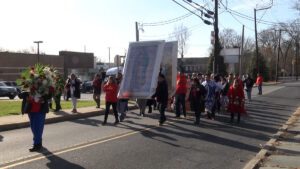EAST STROUDSBURG – In what has become an important community tradition, the Guadalupana Torch arrived in the Poconos on Sunday, Dec. 4, just days before the Feast Day of Our Lady of Guadalupe.
The torch, officially known as Carrera Antorcha Guadalupana, begins its journey each year in Mexico City, crosses the border into the United States and ends in New York City.

For the last several years, parishioners from Saint Matthew Parish in East Stroudsburg have welcomed the torch into the Diocese of Scranton as part of its long journey.
“It’s a special event. Everybody is included,” parishioner Karla Carrasco, said. Carrasco said the torch has special significance, connecting families who have relatives on both sides of the United StatesMexico border, that cannot be together for one reason or another.
“All of those people that touch it and bear it and all those families from Mexico who aren’t able to be with their families here in the United States, they are able to touch the torch and know that their loved ones touched it in Mexico,” she explained.
Stephanie Albuja came back from college just to see the Guadalupana Torch arrive locally this year. She participated in a procession with the torch through the streets that ended at Saint Matthew Parish.
“I think it’s very important to have events like this in public because it attracts other people that aren’t from the parish or are from other churches and they can all come and celebrate with us,” Albuja said.
Keyla Carrasco emphasized the torch procession is not just for the Hispanic community.
“It is incredible seeing everyone gathered together, different colors, different races,” she explained. “It is something that touches everybody when they see the replica of the Blessed Virgin Mary that accompanies the torch.”
Carrasco said she grows in her faith each year by participating in the torch procession.
“You see you’re not alone in your faith,” she explained.
Miguel Vaca, who came to the Poconos nearly 30 years ago, is happy to see more people getting involved in the procession each year.
“We have not only Mexican people, but we have people from Ecuador, Colombia, Venezuela and all those countries that speak Spanish,” Vaca said. “We get together and we experience the love that we give to the Virgin Mary and the love that the Virgin Mary gives to us.”
